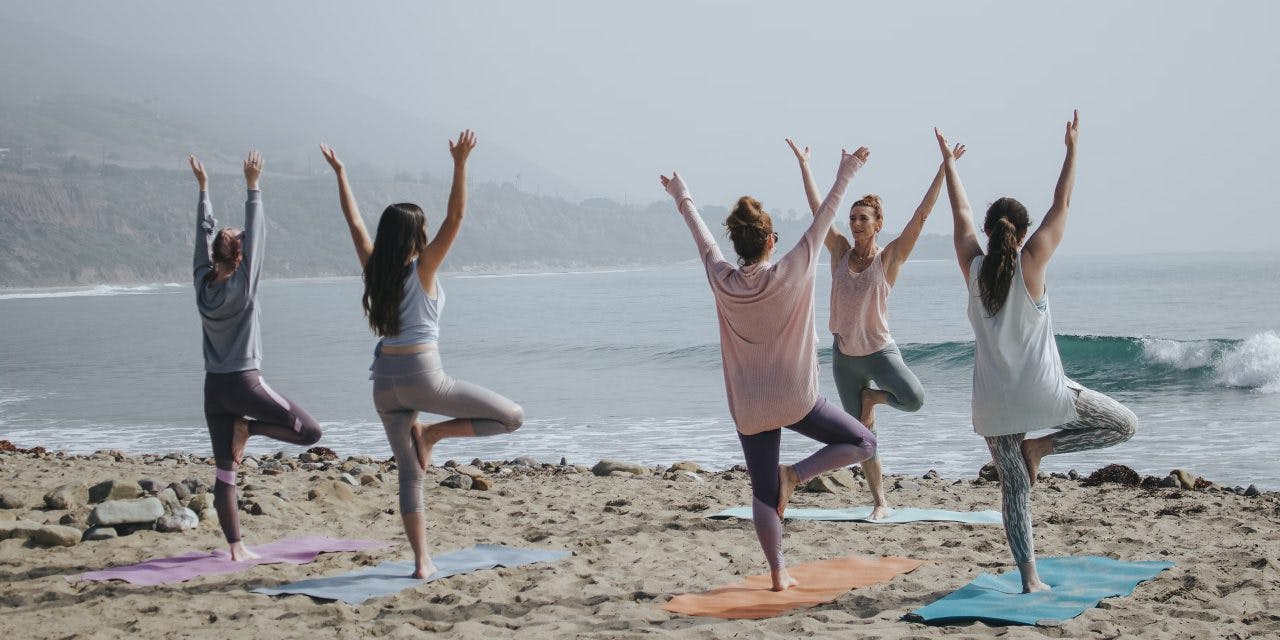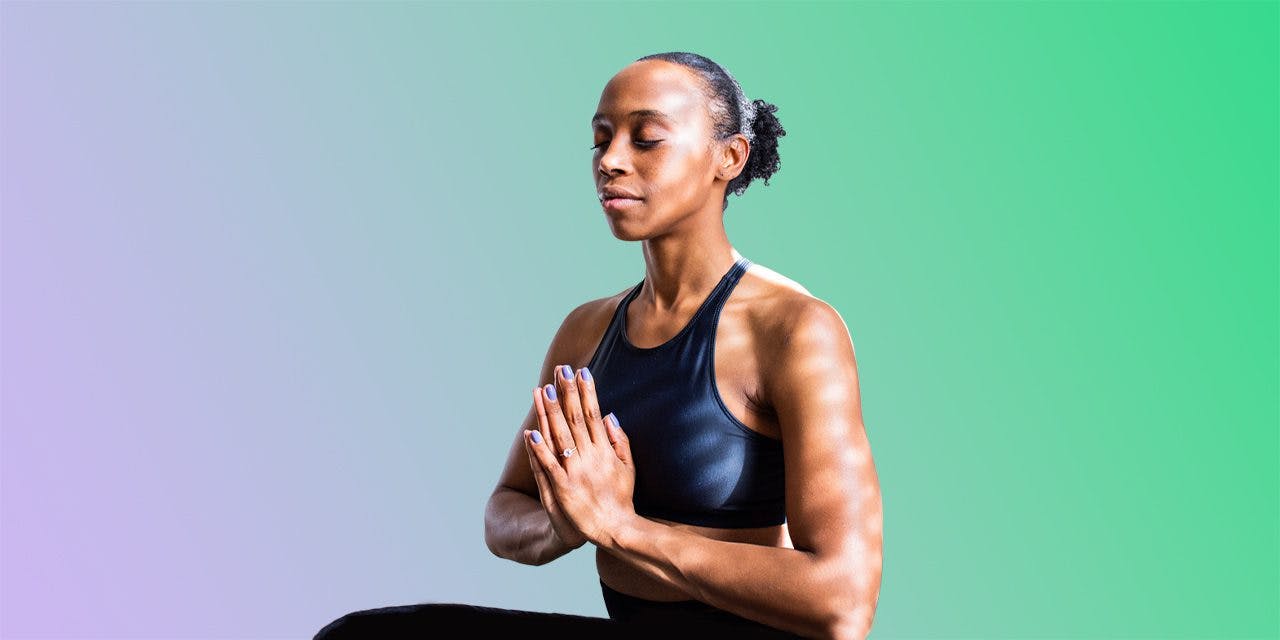Yoga and Marijuana: How to Pair Cannabis and Yoga

Article written by

Shanti RyleContent Writer
Content reviewed by

Dr. Lewis JasseyMedical Director - Pediatric Medicine
As cannabis becomes more widely accepted and integrated into daily life, many yoga practitioners are experimenting with incorporating the plant into their practice. It makes sense, as both weed and yoga can help cultivate a sense of mindfulness and improve overall health and quality of life.
Both yoga and cannabis share a common history, originating in India and stretching back thousands of years. Research in recent years has revealed many benefits of working out while high, including the pleasant euphoria of THC and the anti-inflammatory benefits of cannabis’ other components (although we would generally recommend people to use THC-rich cannabis after their workouts).
Read on to learn more about successfully integrating marijuana into your yoga practice and what to know about yoga and cannabis use.
Get your medical marijuana card
Connect with a licensed physician online in minutes.
What Is Yoga?
Yoga was first developed as a philosophy and physical exercise practice in ancient India approximately 5,000 years ago, though it became popular in the U.S. in the 1960s.
Over the last few millennia, many styles of yoga emerged, including Vinyasa yoga (aka “flow yoga”), Hatha yoga (focused on breathwork), and the peaceful stretches involved with Yin yoga, among many others. They all share a common framework of bringing mind, body, and awareness into alignment. This makes yoga a natural choice for coupling with cannabis use, as the gentle euphoria of weed can often make for a more mindful and spiritual practice.
In the West, the most commonly practiced types of yoga are the more energetic Vinyasa and slower-paced Hatha.
Benefits and Risks of Combining Weed and Yoga
Benefits
People historically have turned to cannabis, as well as other sacred plants, to achieve heightened states of awareness and for other spiritual purposes.
Cannabis acts on our endocannabinoid system, which maintains homeostasis and overall balance in the body’s various processes and central nervous system. Like yoga, it also heightens our sensory awareness, providing a more present insight into one’s inner self than how we operate daily.
Pain relief is another reason why one may choose to exercise with yoga. THC and several cannabinoids found in cannabis have analgesic properties, which research has shown to be just as effective as many prescription painkillers without many of the same side effects. And if you find yourself sore after practice, weed is a useful option for speeding up recovery and alleviating muscle cramps.
As another example, those undergoing cancer treatments may still want to practice yoga or find relief in regularly meeting with their yoga community. Cannabis may help these individuals relieve pain and allow them to attend yoga classes more frequently.
Individuals with anxious or racing thoughts may also find it a good idea to incorporate smoking weed as preparation for their yoga routine. Stoned yoga allows the mind to relax and focus on breathing and postures, free from self-consciousness or life stressors.
Risks
Most ganja yoga practitioners consume before starting their practice, allowing enough time ahead of consumption to feel the effects throughout each exercise.
Based on your experience level, this will be different for every person; but when under the influence of weed, it can become easier to overextend and hurt yourself without meaning to. However, when you’re in the studio, work with yoga teachers to avoid poses with a higher risk of injury.
To mitigate the risk of injury, we recommend using only a tiny amount of THC or a strain with higher amounts of CBD to connect more deeply with your yoga practice. If doing yoga high doesn’t sound appealing, using weed after the fact may enhance its health benefits.
Some strains of cannabis can have the opposite mental effect on users and cause paranoia or anxiety. Choosing what cultivars work best for you is important; opt for ones that produce mild euphoria and some energy without causing internal stress. Consuming cannabis can also cause dehydration, so drinking plenty of water before and during your practice is important.
Finally, the smell of marijuana smoke may not be the most welcome in the average yoga studio and may make breathing challenging for yourself and others. Weed’s aromas stick to clothes and linger long after you’ve finished smoking, so if you want to bring cannabis yoga into your studio, opt for a smokeless consumption method.
How to Pair Marijuana and Yoga
Choose the Right Strain
Yoga is all about aligning mind, body, and spirit, so you’ll want to opt for a strain that brings gentle awareness to both without accelerating thoughts or weighing down your body.
A sativa-dominant, limonene-rich, low-myrcene hybrid may add mild, focused warmth to more energetic vinyasa yoga practices. In contrast, an indica-leaning, myrcene-rich hybrid is better suited to slow, restorative sessions and meditation. Be aware of what terpenes and cannabinoid ratios are in the strain (cultivar) you choose, as these all play into how the plant impacts your endocannabinoid system and subjective experience.
Stick to Slower Yoga Practices
When in doubt, choose slower-moving yoga routines when smoking weed. It can be easy to hurt yourself if you move fast or attempt complicated poses. There are many good reasons to try stoned yoga, but not at risk of injury.
Choose a Lower Dose
Even if you’re used to cannabis, try using a lower dose of weed when introducing it into your yoga class. Yoga’s focus on breathing creates a heightened awareness similar to cannabis-induced euphoria, so you don’t need as much of the plant to get the same look into your inner self.
Hydrate Before and During Your Workout
Exercise produces sweat and depletes the water in your body, while cannabis is naturally dehydrating. It’s important to drink plenty of fluids before, during, and after your workout to keep your hydration levels healthy.
Opt for Smoke-Free Delivery
Yoga is rooted in breath, and smoking could impact your lung’s breath capacity and introduce harmful carcinogens, causing you to choke. Instead of burning your weed, opt for vaporizing flower or concentrates. You can also eat a low-dose edible or use a tincture for longer-lasting effects that will persist through lengthy practices.
When and How Much to Consume
Smoking and vaping produce the most immediate effects if you’re consuming right before your practice begins. If you have more time, opting for a light edible, tincture, or sublingual spray will produce the desired effects in about 90 minutes.
Again, consume a smaller dose than you think you’ll need, or opt for a strain with more CBD than THC. You can always gradually increase your amount but can’t take back what you’ve already consumed.
Get Your Medical Card
Connect with a licensed physician online in minutes.
Frequently Asked Questions
Why do I feel stoned after yoga?
Yoga’s natural “high” comes from the body’s endocannabinoids, which act on your endocannabinoid system with bliss-producing compounds that act similarly to THC and other cannabinoids in weed.
Can you do yoga while stoned?
Yoga is a light, mindful exercise that pairs well with cannabis use. However, using less than you think you need is important, as there is some risk of injury or overexertion. Some would also argue that if you are doing yoga “stoned,” you are not necessarily in a balanced state of mind, which is what yoga intends to achieve.
Those who utilize cannabis before their yoga sessions should be mindful of their cannabis consumption and use it only if necessary.
Can you smoke before yoga?
Smoking cannabis before a yoga class is an excellent way to introduce its euphoric effects into your practice quickly. However, you may want to opt for a smokeless consumption method, as smoke can harm your lungs and compromise your ability to breathe, which is central to yoga routines. You may opt to leave using cannabis until after your session, especially if you are doing a more physically intensive style of yoga such as Bikram or power yoga.



